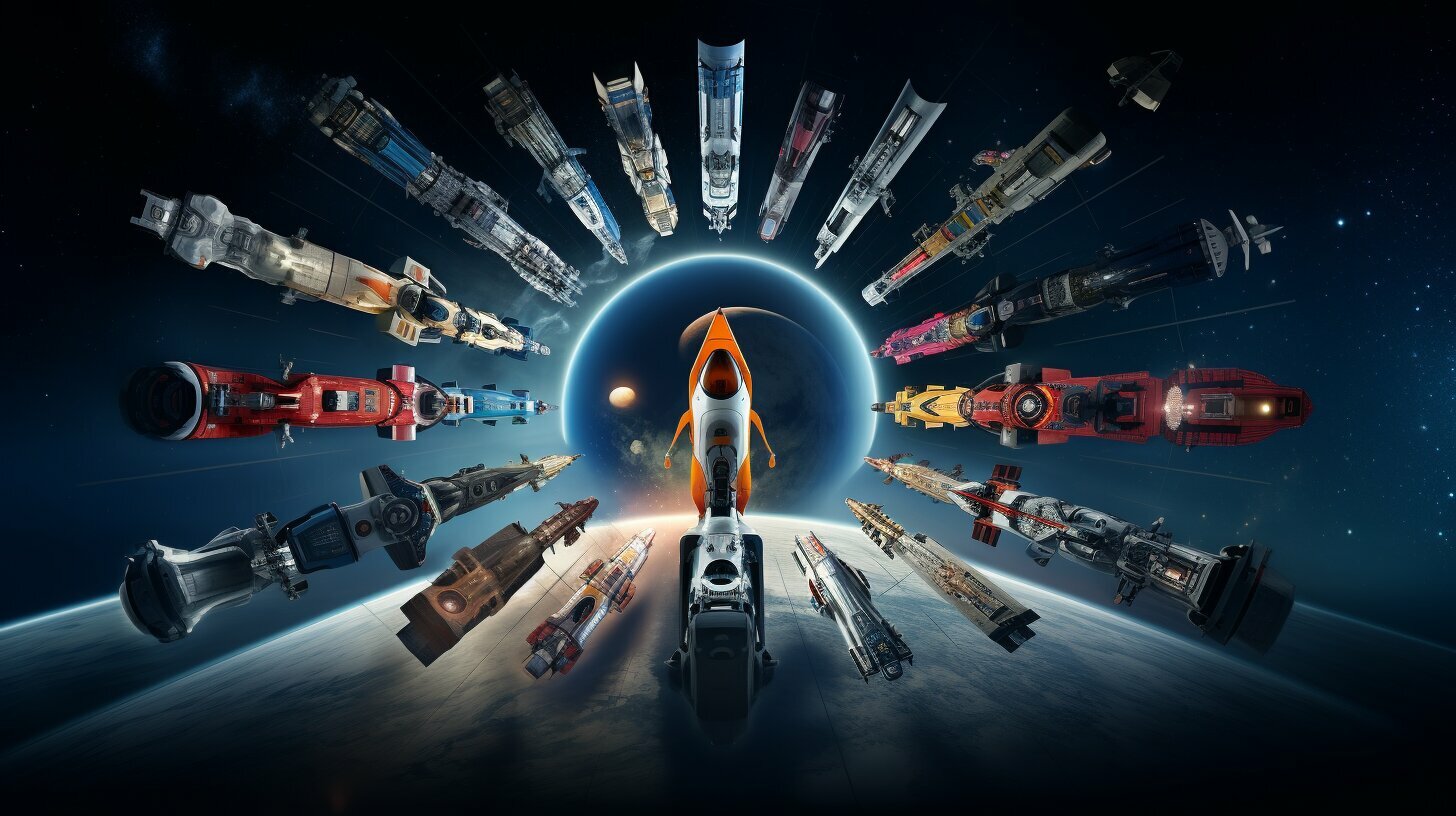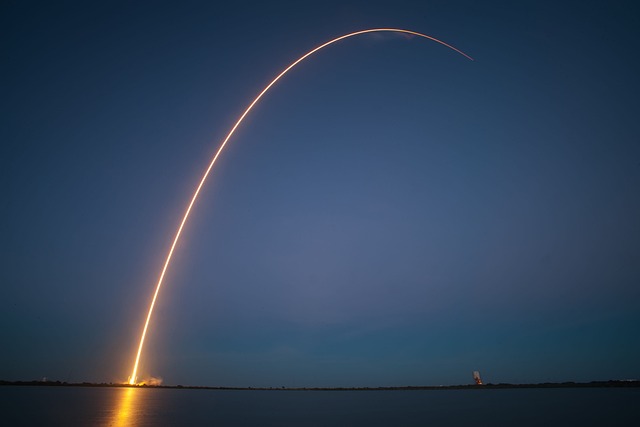
Major Players in Private Sector Space Race
Since the launch of Sputnik in 1957, space exploration has been a domain of governments and their space agencies. However, in recent years, the private sector has surged ahead to explore outer space and commercialize it. Key players in this private sector space race have emerged, each with a unique vision and innovative spacecraft designs. In this context, the private sector includes public companies, excluding government agencies.
This article will provide an overview of the major players in the private sector space race. It will highlight their goals and achievements, as well as their spacecraft designs and initiatives to explore the cosmos. From SpaceX and Blue Origin to Virgin Galactic, Boeing, Lockheed Martin, Northrop Grumman, Sierra Nevada Corporation, and Axiom Space, this article will delve into the exciting and rapidly evolving world of commercial space exploration.
SpaceX: Revolutionizing the Private Sector Space Race
SpaceX, founded by entrepreneur and visionary Elon Musk in 2002, has been at the forefront of the private sector space race for nearly two decades. With a focus on reusable rockets and the colonization of Mars, the company has been pushing the boundaries of space exploration and commercialization.
The Vision of Elon Musk
Elon Musk, the founder and CEO of SpaceX, has a bold vision for the future of space exploration. He believes that humanity should become a “multi-planetary species” by colonizing Mars and establishing a sustainable presence on the red planet. Musk’s goal is not just to explore outer space, but to make it accessible and affordable for everyone.
Reusable Rockets
One of the key innovations of SpaceX is its reusable rockets. Traditional rockets are discarded after a single use, which makes space travel incredibly expensive. However, SpaceX has developed technology that allows their Falcon 9 rockets to return to Earth and land vertically, so they can be used again on future missions. This has significantly reduced the cost of launching payloads into space.
SpaceX has also been working on developing a fully reusable spacecraft, called Starship, which they plan to use for missions to Mars and beyond.
Mars Colonization
One of SpaceX’s most ambitious goals is to establish a human settlement on Mars. In 2020, the company successfully launched and landed a prototype of their Starship spacecraft, which they plan to use for future Mars missions. They are also working on developing technologies to make life sustainable on the red planet, such as terraforming and creating a self-sustaining ecosystem.
SpaceX’s ultimate goal is to make space travel and colonization affordable and accessible to everyone, and they are well on their way to making that a reality.
Blue Origin
Blue Origin, founded in 2000 by Amazon CEO Jeff Bezos, aims to make space travel more accessible with its suborbital space tourism plans. The company’s New Shepard spacecraft has completed multiple successful test flights, and its passengers will be able to experience weightlessness and view Earth’s curvature from the edge of space.
In addition to space tourism, Blue Origin is also focused on developing a lunar lander as part of NASA’s Artemis program, which aims to return humans to the Moon by 2024. The Blue Moon lander, which is designed to carry cargo and eventually crew, has been in development since 2017.
Blue Origin’s Vision
Blue Origin’s ultimate goal is to help humanity become a space-faring civilization by exploring and commercializing space. The company believes that by doing so, we will not only expand our knowledge of the universe but also help improve life on Earth through technologies developed for space exploration.
“We’re committed to building a road to space so our children can build a future.” – Jeff Bezos, Blue Origin Founder
Notable Achievements
| Year | Achievement |
|---|---|
| 2015 | New Shepard becomes the first reusable rocket to reach the edge of space and land successfully |
| 2016 | New Shepard completes its fourth successful test flight, demonstrating its safety and reliability for future space tourism passengers |
| 2017 | Blue Origin announces its plans for the Blue Moon lunar lander |
| 2019 | New Shepard completes its tenth test flight, marking a major milestone in the development of the suborbital space tourism market |
Blue Origin’s achievements in the private sector space race demonstrate its commitment to making space travel more accessible for future generations. With plans to launch suborbital space tourism flights and develop a lunar lander, Blue Origin is poised to make a significant contribution to the commercialization of space.
Virgin Galactic
Virgin Galactic, founded by billionaire Richard Branson in 2004, is a spaceflight company focused on space tourism. The company’s main spacecraft is the VSS Unity, a suborbital vehicle developed to carry passengers on brief trips to the edge of space.
Virgin Galactic’s unique spacecraft design features a carrier aircraft that carries the VSS Unity to an altitude of about 50,000 feet before releasing it. The spacecraft then ignites its rocket motor, propelling it to an altitude of about 55 miles (89 kilometers), where it experiences a few minutes of weightlessness before gliding back to Earth for a runway landing.
Space Tourism
Virgin Galactic’s main goal is to develop commercial space tourism, allowing paying customers to experience the thrill of spaceflight. The company has already sold hundreds of tickets for suborbital flights, with the cost of each ticket estimated to be around $250,000.
The company has faced some setbacks, including a fatal accident during a test flight in 2014. However, after extensive testing and development, Virgin Galactic appears to be moving closer to commercial operations.
Future Plans
Virgin Galactic has announced plans to develop a high-speed point-to-point travel service, using the same technology and infrastructure as their suborbital space tourism flights. The company also has ambitions to develop a larger spacecraft capable of reaching orbit, but these plans are still in the early stages.
Boeing
Boeing is a major player in the private sector space race, with a focus on partnership with NASA and ISS missions. Their spacecraft, the CST-100 Starliner, is designed to transport crew and cargo to the International Space Station. The spacecraft has undergone a series of tests and is expected to begin regular missions soon.
Boeing also participates in NASA’s Commercial Crew Program, a partnership program that aims to develop commercial spaceflight capabilities. The program aims to reduce the cost of space travel and expand access to outer space. Boeing’s involvement in the program has propelled the company’s efforts to explore outer space further.
With the expansion of commercial space activities, Boeing has also set its sights on exploring deep space. The company is currently developing the Space Launch System (SLS), a heavy-lift rocket that will enable missions to the moon and beyond.
CST-100 Starliner
The CST-100 Starliner is Boeing’s spacecraft designed to transport crew and cargo to the International Space Station. The spacecraft can carry up to seven passengers and can stay in space for up to seven months. It is reusable and can fly up to ten missions.
The CST-100 Starliner has undergone extensive testing to ensure its safety and reliability. In December 2019, the spacecraft conducted an uncrewed test flight to the International Space Station. Although the mission did not go as planned, Boeing has made significant progress in fixing the issues and preparing for future missions.
NASA Partnership
Boeing has a long-standing partnership with NASA, dating back to the 1960s when the company was involved in the Apollo missions. Today, Boeing continues to work with NASA on a variety of space projects, including the Commercial Crew Program.
The Commercial Crew Program is a public-private partnership that aims to develop spacecraft capable of transporting astronauts to the International Space Station. Boeing’s CST-100 Starliner is one of two spacecraft developed under the program (the other being SpaceX’s Crew Dragon).
ISS Missions
Boeing’s CST-100 Starliner is designed to transport crew and cargo to the International Space Station. The spacecraft is expected to conduct regular missions to the space station in the near future. These missions will enable NASA to continue its research on space and prepare for future missions to the moon and beyond.
Boeing has a long history of involvement in manned spaceflight, and its efforts in the private sector space race are a continuation of this legacy. Through partnerships with NASA and other commercial entities, Boeing is advancing space exploration and expanding access to outer space.
Lockheed Martin
Lockheed Martin is a prominent player in the private sector space race, spearheading advancements in deep space exploration with their Orion spacecraft.
The Orion spacecraft is designed to transport astronauts beyond low Earth orbit and into deep space. It has also been selected by NASA to carry humans to the Moon as part of the Artemis program. With several successful test flights under its belt, the spacecraft is well on its way to making deep space exploration a reality.
In addition to the Orion spacecraft, Lockheed Martin is also developing a lunar lander capable of transporting astronauts to the Moon’s surface. The lander will be an important component of the Artemis program’s goal of landing the first woman and next man on the Moon by 2024.
Lockheed Martin is also working on several other projects aimed at advancing space exploration, including satellite servicing technology and autonomous spacecraft operations.
The Next Frontier
Lockheed Martin’s Orion spacecraft is a crucial component in deep space exploration, as it will enable humans to reach farther into the solar system than ever before. With plans to use the spacecraft for lunar missions and potentially even Mars missions, the future of space travel looks bright with Lockheed Martin leading the way.
Northrop Grumman
Northrop Grumman is an American global aerospace and defense technology company involved in the development of advanced weapons systems and military technology. In recent years, the company has also expanded its focus to include space exploration projects.
One of Northrop Grumman’s major achievements in the private sector space race is the development of the Antares rocket. This two-stage rocket is designed to transport payloads and satellites into space and is capable of delivering payloads weighing up to 8,000 kg to low-Earth orbit.
In addition to the Antares rocket, Northrop Grumman has also developed the Cygnus spacecraft, which is used to deliver supplies to the International Space Station (ISS). The Cygnus spacecraft is launched using the Antares rocket and is capable of carrying up to 3,700 kg of cargo.
Northrop Grumman and NASA
Northrop Grumman has a long-standing partnership with NASA and has played an important role in many of the agency’s space exploration projects. The company has been involved in numerous missions, including the James Webb Space Telescope, which is set to be launched in 2021, and the Lunar Gateway project, which aims to establish a permanent presence on the moon.
Recently, Northrop Grumman was awarded a contract by NASA to develop a lunar lander that will transport astronauts to the moon’s surface as part of the agency’s Artemis program. The lander, called the National Team Human Landing System, is being developed in collaboration with Blue Origin and Draper and is expected to be completed by 2024.
Sierra Nevada Corporation
Sierra Nevada Corporation (SNC) is a private American aerospace company that designs and builds advanced technology products and systems for commercial, military, and space markets. Founded in 1963, SNC has been at the forefront of the private sector space race, particularly in developing a reusable spaceplane for missions to low Earth orbit.
Their flagship spacecraft, Dream Chaser, is a reusable spaceplane that is capable of transporting crew and cargo to and from low Earth orbit. Unlike other spacecraft, Dream Chaser is designed to land horizontally, allowing for easy ground transportation of cargo and crew. SNC has been working closely with NASA to develop Dream Chaser as a transportation system to and from the International Space Station (ISS) and other orbital destinations.
In addition to Dream Chaser, SNC is also developing technologies for advanced missions beyond Earth’s orbit. They are currently involved in the development of the HALO module, a habitat that will support astronauts on deep space missions. HALO can be used as a standalone habitat or docked to other spacecraft, making it a versatile option for deep space exploration.
Through their contributions to the private sector space race, SNC is working towards a future where space missions are more accessible and sustainable. With their innovative technologies and collaborative partnerships with organizations like NASA, SNC is poised to play a crucial role in commercializing space exploration.
Axiom Space: Commercial Space Station and Partnership with NASA
Axiom Space is a private American aerospace manufacturer and spaceflight services company that was founded in 2016. The company’s primary goal is to establish and operate the world’s first commercial space station. Axiom Space plans to attach their commercial modules to the International Space Station (ISS) which will enable them to provide a range of services to customers. The company has been working closely with NASA to achieve this goal.
Additionally, Axiom Space has signed a contract with SpaceX to transport their crew to the ISS and back using the Crew Dragon spacecraft. This partnership will play an important role in the development of Axiom Space’s commercial space station, as Crew Dragon will be used to transport both their crew and equipment.
Axiom Space has also announced plans to develop their own spacecraft, the Axiom Station Crew Vehicle. The spacecraft is currently in development and will be used to transport crew members to and from the commercial space station once it is fully operational.
Axiom Space’s Partnership with NASA
Axiom Space has a strong partnership with NASA, which has been essential to the company’s plans to establish a commercial space station. In January 2020, NASA selected Axiom Space as the first U.S. commercial company to attach a module to the ISS for a commercial purpose. This milestone agreement enables Axiom Space to connect their commercial modules to the ISS’s Node 2 forward port, which was previously occupied by the space shuttle.
The partnership with NASA has enabled Axiom Space to utilize the resources and expertise of the space agency. Axiom Space has worked closely with NASA to ensure that their commercial modules meet the agency’s safety and performance standards. Furthermore, NASA has agreed to provide Axiom Space with a number of services, including power, data, and communication.
Axiom Space’s partnership with NASA demonstrates the importance of collaboration between the private sector and government agencies. This partnership has opened up new opportunities for commercial space exploration and has paved the way for a new era in space travel.
FAQ
In this section, we will answer some frequently asked questions about the private sector space race:
What is the private sector space race?
The private sector space race is the competition between companies to explore outer space and commercialize it for economic and scientific purposes.
What are the goals of the major players in the private sector space race?
The major players in the private sector space race have different goals, ranging from space tourism to deep space exploration. Some are focused on building reusable rockets, while others are working on developing space stations or mission to Mars.
Who are the key players in the private sector space race?
The key players in the private sector space race include SpaceX, Blue Origin, Virgin Galactic, Boeing, Lockheed Martin, Northrop Grumman, Sierra Nevada Corporation, and Axiom Space.
What are the achievements of the private sector space race?
The private sector space race has achieved significant milestones, including the successful launch and landing of reusable rockets, the deployment of satellites, the launch of crewed missions to the International Space Station, and the testing of spacecraft intended for space tourism and deep space exploration.
How does the private sector space race differ from government space programs?
The private sector space race differs from government space programs in that it is driven by commercial interests and is not solely focused on scientific research. Private companies aim to profit from space exploration and development while also contributing to scientific knowledge.





